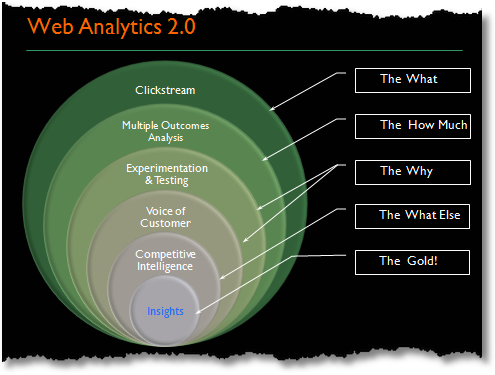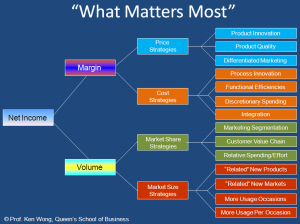I read Occam’s Razor for quite a while now and I really like Avinash’s style and insights. I thought it would be nice to reread most of his stuff and as a nice extra, I will post my notes on here.
I oriented each section by the section defined in his overview of all articles.
Enjoy!
The 10 / 90 Rule for Magnificent Web Analytics Success
- There is lots of data but no insights
- Rule: 10% in tools and 90% people/analysts
- may seem over the top but
- med-large websites are complex
- reports aren’t meaningful by default
- tools have to be understood
- there is more than clickstream to analytics
- If you don’t follow the 10 / 90 Rule
- Get GA account
- Track parallel to expensive solution
- Find a metrics multiplier, so you can compare GA to old data
- Cancel your contract and hire an smart analyst which will probably deliver more insights for less money
Trinity: A Mindset & Strategic Approach
- The goal is to generate actionable insights
- Components:
- Behavior analysis: clickstream data analysis
- Outcomes analysis: Revenue, conversion rates, Why does your website exist?
- Experience: Customer satisfaction, testing, usability, voice of customer
- Helps you understand what customer experience on your site, so that you can help influence their behavior
The Promise & Challenge of Behavior Targeting (& Two Prerequisites)
- We have so much behavior data but you get the same content regardless whether you are here to buy or get support
- There are BT systems but you have still think about the input
- You have to first understand your customers good enough to create suitable content
- Test content ideas first to learn what works and as evidence for HiPPOs
Six Rules For Creating A Data Driven Boss!
- Paradox: The bigger the organization the less likely it is data driven in spite of spending lots of money on tools
- It is possible to achieve this but you have to actually want to do and fight for it
- 1. Get over yourself: Learn how to communicate with your boss and try to solve his problems
- 2. Embrace incompleteness: Data is messy, web data is really messy but still better than completely faith based initiatives.
- 3. Give 10% extra: Don’t just report data, look at it. Give him insights he didn’t asked for. Make recommendations and explain what’s broken.
- 4. Become a marketer: Great analysts are customer people. Marketer as internal customer (like account plannner)
- 5. Don’t business in the service of data: Data should provide insights not just more data. Ask: how many decision have been made based on data that have added value to the revenue?
- 6. Adapt a Web Analytics 2.0 mindset:

Lack Management Support or Buy-in? Embarrass Them!
- HiPPOs may be don’t listen to you but they better listen to customers & competitors
- 1. Start testing
- 2. Capture Voice of Customer: Surveys, Usability tests, etc.: Let the customer do the talk
- 3. Benchmark against the competition, e.g. use Fireflick
- 4. Use Competitive Intelligence
- 5. Start with a small website
- 6. Ask outsiders for help
How To Excite People About Web Analytics: Five Tips.
- 1. Give them answers
- 2. Talk in outcomes / measure impact
- 3. Find people with low hanging fruit and make them a hero
- 4. Use customers & competitors
- 5. Make Web Analytics fun: Hold contests, hold internal conferences, hold office hours
Redefining Innovation: Incremental, w/ Side Effects & Transformational
- 1. Incremental innovation, e.g. Kaizen
- 2. Incremental innovation with side effect, e.g. iPod or Adsense
- 3. Transformational innovation, e.g. invention of the wheel
- Web analytics can’t probably create 3
- Clickstream alone is also not enough for 1.
- generally the more the better (Web analytics 2.0)
Six Tips For Improving High Bounce Rate / Low Conversion Web Pages
- Purpose gap between customer intent and page
- 1. Learn about traffic sources / keywords(!)
- 2. Do you push your customers against their intent? Identify jobs of each page and focus on your call to actions.
- 3. Ask your customer what they are looking for
- 4. Get insights from site overlays
- 5. Testing!
- 6. Get first impressions from people, e.g. fivesecondtest
Online Marketing Still A Faith Based Initiative. Why? What’s The Fix?
- Faith based initiatives like TV, magazines, etc.
- Online marketing gives us useable data
- and allows us to test easily
- The web is quite old yet it is not in the blood of executives
- Old mental: shout marketing, instead of new inbound marketing
- Lousy standards for accountability
- Let the customers speak
- Benchmark against competition
Win With Web Metrics: Ensure A Clear Line Of Sight To Net Income!
- Focus on the bottom line, i.e. profits
- 1. Identify your Macro Conversion
- 2. Report revenue
- 3. Identify your Micro Conversions
- 4. Compute the economic value
- Net income = Unit Margins * Unit Volumes
- Unit Margins = Price – Cost
- Unit Volumes = Market Share * Market Size
- Because Net Income is the goal, you have to measure Price, Cost, Market Share or Market Size
- Which metrics help doing that? And if not, why do you track/report this metric?
- They also depend on the strategies or more general goals of the organization
 — let your “boss” decide what matters most to him/organization
— let your “boss” decide what matters most to him/organization- identify clear metrics / KPIs for each used strategy
- use the web analytics measurement framework as a reporting foundation (more to this later)
- find actionable insights with segmented analysis
Digital Marketing and Measurement Model
- Marketing with measuring helps you to identify success and failure
- Digital Marketing & Measurment Model
- Set business objectives (should be DUMB)
- Doable
- Understandable
- Manageable
- Beneficial
- Identify goals for each objective
- Get KPIs for each goal
- Set targets for each KPI
- Identify segments of people / outcomes / behavior to understand why things succeeded or failed
- What scope has the model to cover?
- Acquisition: How do people come on your site? Why? How should it be?
- Behavior: What should people do on your site? What are the actions they should take? How do you influence their behavior?
- Outcomes: What are the goals? (see previous summary)
11 Digital Marketing “Crimes Against Humanity”
- Not spending 15% of your marketing budget on new stuff
- Not having a fast, functional, mobile-friendly website
- Use of Flash
- Campaigns that lead to nowhere
- Not having a vibrant, engaging blog
- “Shouting” on Twitter / Facebook
- Buying links is your SEO strategy
- Not following the 10/90 rule
- Not using the Web Analytics Measurement Model (previous summary)
- Using lame metrics: Impressions, Page Views, etc.
- Not centering your digital existence on Economic Value


